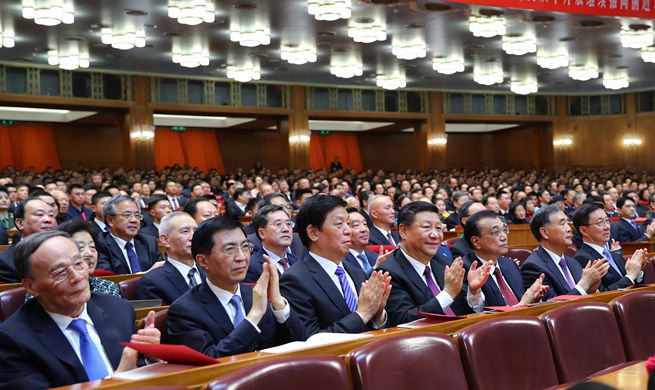By Sportswriters Wang Haoming and Qin Lang
SHENZHEN, China, Dec. 16 (Xinhua) -- Kenyan and Ethiopian runners dominated Sunday's 2018 Shenzhen International Marathon, whose organizers had gone to great lengths to ensure a clean race after a half marathon here last month was marred by a major cheating scandal.
The marathon took place under a great deal of scrutiny, after 258 runners were caught cheating in the Shenzhen Nanshan half marathon three weeks ago. 18 runners with fake bib numbers and three running on behalf of others were given lifetime bans from the event. The other 237 runners, of whom a great number had taken shortcuts, were banned for two years.
With over 30,000 people competing in Sunday's event, Kenya's Edwin Kipngetich Koech came home first in a time of two hours nine minutes and 44 seconds while Mulu Seboka Seyfu of Ethiopia took the women's title in 2:27:12. Zhang Zhenlong was the first Chinese runner to cross the tape, finishing in 10th overall in 2:20:43.
This time, Shenzhen Marathon organizers had vowed to avoid a repeat of last month's incident, using microchipped wristbands, facial recognition technology, and extensive video monitoring in order to prevent cheating.
"We employed several measures to avoid the possibility of cheating, making it almost impossible to cut corners or use fake bibs," an organizing committee official surnamed Song told Xinhua.
Organizers said the facial recognition technology was capable of identifying unregistered runners, while wristbands fitted with electronic chips were able to accurately record competitors' times as they passed through the course's timing mats, allowing organizers to identify runners suspected of taking shortcuts.
"These are only preventative measures, and we hope the runners choose to respect the sporting spirit of the marathon," Song added.
In addition, organizers also stationed 224 referees and over 3,000 volunteers at various points along the course, and made an official announcement on Wednesday urging runners to "keep to the rules and respect the sporting spirit". The announcement added that competitors wearing fake bibs or running on behalf of others would face a lifetime ban from the event.
Marathon running has surged in popularity in China in recent years. The number of marathons and road races staged in the country grew from just 22 in 2011 to 1,072 this year, according to the Chinese Athletics Association (CAA). But with marathon running still in its infancy in China, such rapid growth has resulted in a few teething problems for runners and organizers alike.
In the Suzhou Marathon in November, local runner He Yinli was handed the Chinese national flag near the finish line and was forced to make an impossible decision - either dropping it and thereby disrespecting the country's standard, or running with it and thereby slowing her down at a crucial juncture in the race.
She ended up finishing second behind Ethiopia's Ayantu Abera Demissie after tossing the flag on the ground.
And, tragically, a runner at the Xiamen International Half-Marathon died after completing a race that he was not registered for.
The marathon explosion here has stunned both domestic and international observers alike. It is important to keep in mind, however, that China has lacked a robust recreational running culture for most of its modern history.
As with any sport, there are rules and regulations to observe, but these take time to become engrained in the social consciousness of a country.
Each of the cases listed above offers its own lessons.
The Shenzhen Half-Marathon incident, which saw more than 200 runners cut through a wooded area in order to shave at least one kilometer off their race, is as much a failure of organization as it is a shameful case of cheating.
Marathon routes should always be clearly demarcated and secure. Evidence suggests that the Shenzhen route was neither of these.
In addition to allowing cheats to cut corners, a poorly delineated route also raises a number of security issues.
A well-organized marathon must mobilize resources along the entire route in order to make sure that those who cross the tape have actually completed the course, and done so safely.
The issue in Xiamen is another dereliction of planning.
The runner who died had not registered with organizers directly, but had instead procured his bib through a third party.
The bib was originally registered to a female runner, as evidenced by it beginning with the letter F, so a simple verification process at the registration desk would have remedied the situation.
Digital technology can help in this regard. Online registration portals, for example, could assign each runner an individual QR code to be placed on their bib when they arrive at the event. The code could then be scanned before the starting gun to provide an additional layer of security.
Lessons can also be learnt from the flag furor.
First and foremost, the appropriate time to hand a runner a flag is after he or she has taken the tape.
The runner in question is plainly owed an apology by the organizers in Suzhou. She was placed in an impossible situation and had no intention of disrespecting the Chinese flag.
By learning from these situations, organizers can improve the quality of both their preparation and execution.
Progress is already being made in instilling a love of marathon running and an embrace of the rules and regulations that it involves.
Chinese runners are traveling abroad to participate in marathons around the globe. This year's New York marathon drew widespread interest from Chinese runners. A terracotta "mini-marathon" was held before the event last month. The main marathon attracted some 224 participants. That number is likely to go up in the coming years.
As more and more everyday Chinese embrace marathon running as part of a healthy lifestyle, it will become ever more imperative to ensure that runners, organizers and the general public are educated about the standards that have to be maintained.
Rather than apportioning blame, the real question that media outlets need to be asking is: How can China learn from these teething problems as it seeks to construct a sustainable, viable and long-term marathon running infrastructure?



















